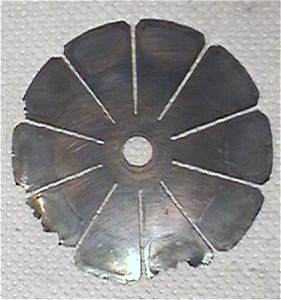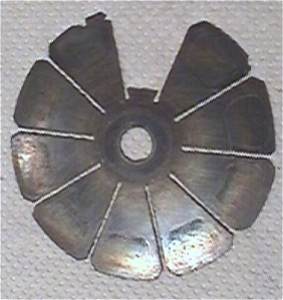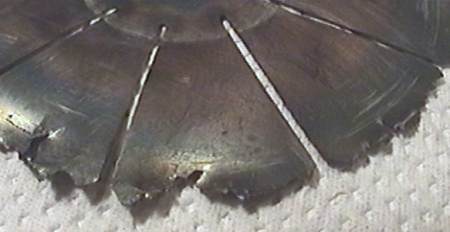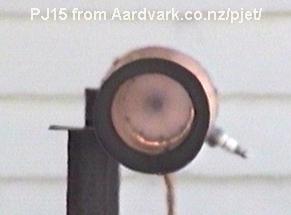Valves -- The Weakest Link?
As anyone who has built or owned a small conventional pulsejet knows, the
reed valves are a consumable item.
Depending on the engine and the conditions under which it's operated, the
reed valves can last anywhere from just a few seconds to 20 minutes or so --
but you can be sure that they will fail at regular intervals.
Etch your own valves
I've created a PDF file which explains how you can
make your own reed valves
using a very simple electrochemical etching process that requires
little more than a 12V battery and some table-salt.
|
|
It's not hard to understand why these fragile little pieces of metal
don't last long. They're slammed back and forth between the intake
and retainer plates with great force, several hundred times per second.
What's more, they're usually exposed to the extremely hot combustion
gasses.
Here are some pictures of typical petal valve damage:
Left: impact/heat damage Right: fatigue damage


Here is an enlarged view of valve damage caused by excessive impact forces
possibly aggravated by excessive overlap with the valve plate.

Factors Affecting Valve Life
As outlined above, there are two main factors which affect valve life:
- Physical forces
- Temperature
If the magnitude and or influence of these two factors can be minimized,
valve life will be extended accordingly.
Minimizing Physical Forces
The magnitude of the forces exerted on the tips of a pulsejet reed valve
are huge and cumulative.
Hi-carbon tempered spring steel is an incredibly tough material. If you don't
believe me, just try putting some on an anvil and hitting it with a hammer.
Such abuse will usually produce little visible
damage. Of course to reproduce the forces applied during just one minute
of pulsejet engine operation, you'd have to whack that piece of metal about
3,500 times.
Another effect of all this movement is metal fatigue. If the valve flexing
exceeds the elastic limits of the material then eventually a crack will
be created and this will rapidly turn into total fracture.
So what can be done to reduce the effect of these physical forces on our
reed valves?
- Keep the valve movement to a minimum.
Instead of using a small valve that requires a large amount of movement
to produce the required effective valved area, you're much better off to
use a bigger valve that moves just a small amount. Small valve movements
generally produce lower valve-tip speeds and this can significantly reduce
the impact forces involved in valve opening and closing. Remember -- when
you double the speed, you quadruple the forces involved.
Unfortunately, the traditional petal-valve design makes it very hard to
produce an engine that has large valves with small opening movements. In
order to achieve such a set-up, the diameter of the front part of the engine
needs to be very much larger than that of the tailpipe -- and that can produce
other undesired side-effects.
As a general rule, I've found that about 6mm (1/4") of tip-travel is about
the maximum you can use with petal valves before valve life becomes
unacceptably short. This becomes a limiting factor in terms of how large
an engine you can build using simple petal-valve technology.
- Provide a smooth landing surface
Any bumps or depressions in the area of the valve-plate against which the
valves impact will produce very high areas of localized stress within the
valve itself.
To draw an analogy -- if you place a sheet of glass on a smooth table
then lift one end and drop it from a small height, it will touch down
quite softly -- the air beneath it providing a cushioning effect.
However, if you place just a small pebble between the glass and the table-top
then repeat the exercise it will land with a thud -- striking the pebble with
some force, possibly even shattering.
This is the effect that you get when the valve-plate is poorly made or damaged.
Small ridges or bumps on the valve plate can create huge stresses within
the reed valve itself.
If you make your valve plate from aluminum, it's a very good idea to choose
a suitable alloy that allows the plate to be anodized. A layer of
anodizing will be far more resilient than raw aluminum and thus
and produce a surface that is less easily damaged by the impact of the valves.
- Don't use excessive overlap
Don't make the mistake of thinking that it's a good idea
to provide plenty of valve overlap against the valve plate. While it might
seem sensible to provide plenty of area for the valve to rest against when
it's pushed onto the valve plate, this simply isn't true.
If you have too much overlap, the air which becomes trapped between the valve
plate and the valve will cause the tips of the valves to bend backwards quite
markedly -- actually increasing the stresses.
Determining the best amount of overlap is actually quite a critical parameter
in obtaining good valve life. Too much overlap and the valves will quickly
split at the tips. Too little overlap and you'll damage the valve plate because
the impact forces will be concentrated on a small area.
And you thought designing pulsejets was easy eh?
Reducing Heat Exposure
The goal of the pulsejet designer should be to try and keep the reed valves
out of the way of the hot combustion gases. Unfortunately this is extremely
difficult to do with traditional designs.
In the ideal engine, the flow of the intake charge/air should be as unrestricted
as possible. The incoming air should be dumped almost straight into the
engine's combustion zone.
Unfortunately, if we provide such a direct path then there's nothing to stop
the hot combustion gases from rushing back towards the intake and hitting
the valves.

Blast Ring(TM) glows red hot while shielding the
valves on a PJ15 (view up tailpipe)
|
I have experimented at length with the addition of devices such as the
Blast Ring(TM) -- a simple metal ring that disrupts the flow of gases back
towards the valves. This is actually every effective at keeping the valves
cool -- but it can only be used with direct-injection engines and has a penalty.
Because it tends to restrict the flow of gases in both directions, the
Blast Ring(TM) does reduce the engine's power. For this reason I have
made it an "optional" component of the engines I sell. If you want to run
your engine for an extended period for demonstration purposes or to test
something such as an augmentor then the blast ring will extend the life
of your valves.
When you want maximum power however, you can simply remove the ring and
power output will increase significantly -- albeit at the cost of valve life.
Another method of reducing valve heating include the use of a flame-mesh/screen
between the combustion zone and the valves. Unfortunately this has an even
greater effect on power than the Blast Ring(tm). Due to the drag created
by such a mesh, the flow of the fresh air/fuel charge into the combustion zone
is significantly impeded -- and the mesh itself (due to its exposure to the
hot gases) tends to have a very limited lifespan.
Non-Traditional Design
As you can probably see from the information above, modifying traditional
pulsejet valving systems to provide more durable and reliable operation
is not trivial.
It was the irritatingly short life-span of conventional reedvalves which lead
me to think long and hard about ways to re-design the entire valving system --
something which ultimately lead to the
XJet design which I've been developing.
Other Options
Of course the ideal solution to the valve-life problem is to ditch the valves
altogether and use a
valveless design.
Unfortunately, valveless designs still have some way to go before they
produce similar efficiencies and power levels to a good valved engine.
The best valveless design I've encountered so far is the
Lockwood engine -- but all the working
examples I've encountered fall short not only of the equivalent valved
engine, but also fail to meet Lockwood's own claims for power or fuel efficiency.
Never the less, there is still a strong contingent of pulsejet experimenters
who are adamant that the only good pulsejet is a valveless one.
| 



